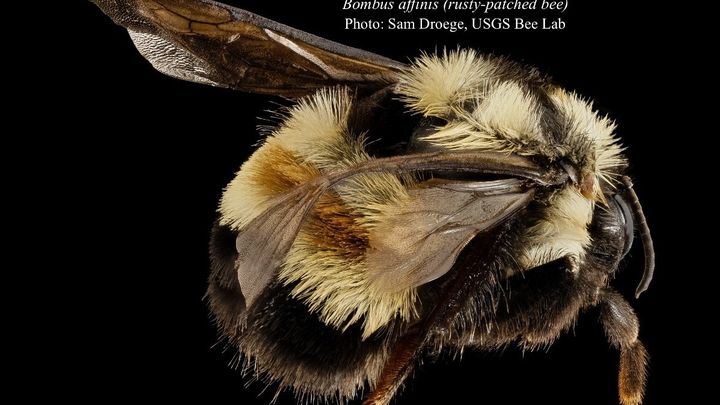
Mapping Virginia Pollinators
Donation protected
I serve on Virginia's Board of Conservation and Recreation and have been greatly impressed with the remarkable science-based conservation work of the Virginia Natural Heritage Program, within the Department of Conservation and Recreation (DCR). While they receive some state funding, projects like this on pollinator mapping are vital and cannot be completed without additional funding streams. I continue to emphasize the value of community-public-private partnership efforts and am asking my community and their networks to help support this innovative effort to discover and map Virginia's over 460 species of bees and other native pollinators. All funds will go to DCR.
A little bit more about this work:
Bee work at the Division of Natural Heritage
Virginia Department of Conservation and Recreation
Native bees are an essential cog of healthy and diverse natural communities. Their role in pollination can be so specialized as to match only a single plant species. Or, some are generalists that help pollinate entire forests. Native bees have been shown to be important pollinators of many agriculture crops and in many cases are more effective than European honeybees. Despite their ecological and economic importance, relatively little is known about native bees in Virginia. Moreover, evidence is mounting that many bees are experiencing widespread population declines. Much like Lepidoptera (butterflies and moths) and Odonata (dragonflies and damselflies) inventories that have been completed in the past, Virginia Natural Heritage set out to answer the fundamental questions regarding native bees in Virginia: how many native species are there, what are they, where do they occur, what habitats do they need, what threatens them and how can we maintain their populations, and the free ecosystem services they provide?
While the work is not complete, exciting finds highlight the value of this work. For example, sampling at South Quay Sandhills Natural Area Preserve (City of Suffolk) has documented multiple species not previously known from Virginia. Among them is a globally rare leaf-cutter bee (Megachile integra, G2G3) thought to use prairies and xeric pinelands, which represented only the second reported record of the species in the East since the 1970s.
In March 2017 the Rusty-patched bumble bee (Bombus affinis G1/S1) became the first native bee in the continental United States to be listed by the Endangered Species Act (USF&WS). In the past two years, Virginia NHP documented more than 20 records of this rare species; now the largest known population east of the Mississippi River. This listing and subsequent findings further highlight the urgency and importance of efforts to better understand Virginia's native bees.
The Bee Team has documented endangered and rare bees, learned more about the distribution and status of Virginia’s bees, compiled a state bee list and built a bee reference collection. Currently, the Virginia Bee List contains 462 species, comprised of 447 native and 15 exotic species. The work continues and your contribution will help support this critical program.
A little bit more about this work:
Bee work at the Division of Natural Heritage
Virginia Department of Conservation and Recreation
Native bees are an essential cog of healthy and diverse natural communities. Their role in pollination can be so specialized as to match only a single plant species. Or, some are generalists that help pollinate entire forests. Native bees have been shown to be important pollinators of many agriculture crops and in many cases are more effective than European honeybees. Despite their ecological and economic importance, relatively little is known about native bees in Virginia. Moreover, evidence is mounting that many bees are experiencing widespread population declines. Much like Lepidoptera (butterflies and moths) and Odonata (dragonflies and damselflies) inventories that have been completed in the past, Virginia Natural Heritage set out to answer the fundamental questions regarding native bees in Virginia: how many native species are there, what are they, where do they occur, what habitats do they need, what threatens them and how can we maintain their populations, and the free ecosystem services they provide?
While the work is not complete, exciting finds highlight the value of this work. For example, sampling at South Quay Sandhills Natural Area Preserve (City of Suffolk) has documented multiple species not previously known from Virginia. Among them is a globally rare leaf-cutter bee (Megachile integra, G2G3) thought to use prairies and xeric pinelands, which represented only the second reported record of the species in the East since the 1970s.
In March 2017 the Rusty-patched bumble bee (Bombus affinis G1/S1) became the first native bee in the continental United States to be listed by the Endangered Species Act (USF&WS). In the past two years, Virginia NHP documented more than 20 records of this rare species; now the largest known population east of the Mississippi River. This listing and subsequent findings further highlight the urgency and importance of efforts to better understand Virginia's native bees.
The Bee Team has documented endangered and rare bees, learned more about the distribution and status of Virginia’s bees, compiled a state bee list and built a bee reference collection. Currently, the Virginia Bee List contains 462 species, comprised of 447 native and 15 exotic species. The work continues and your contribution will help support this critical program.
Organizer
Vivek Shindepatil
Organizer
Arlington, VA
Begin your fundraising journey


